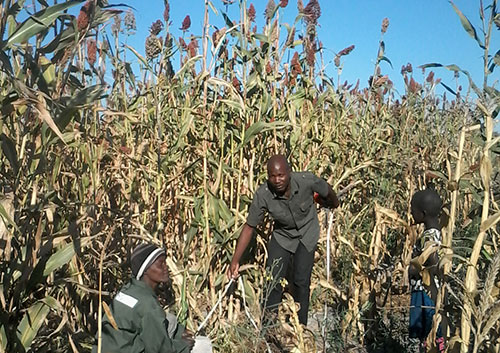
WINDHOEK – There is just no end to the success stories of communal farmers applying the proven method of Conservation Agriculture in their maize and mahangu fields.
Scores of small scale farmers have reported outstanding yields since Farmers Forum published the record-breaking harvest of 6 060 kg of mahangu per hectare by Vilho Nande on his farm in the Oniipa constituency in the Oshikoto region. Hot on the success of their maize and mahangu yields comes the amazing sorghum yields of up to 8 200 kg per hectare recorded last week by Nikodemus Kaupitwa and Cesilia Haitula. Both are lead farmers on the Namibia Conservation Agriculture Project (NCAP) in Okaku constituency, Oshana region. Nikodemus attended an NCAP conservation agriculture training for lead farmers last September. They have two hectares under ripping furrowing at their farm where they train interested neighbours. As Cesilia markets sorghum, it was important for the couple to trial their indigenous sorghum seed under CA. Field Coordinator Gideon Nantinda told farmers Forum that farmers are astounded by the harvest which is the highest ever recorded in the area.
”I am very happy with this year’s harvest because I have never had such a high yield. When using disc harrows I never got anywhere near this kind of yields. This is good for my business as I market sorghum in my community. I sell sorghum for N$ 312 per 50 kg to ladies who make oshikundu for daily consumption and omaluvo giilya for weddings and other festivities. Sorghum is an important crop in our local economy. With this years’ yield I can start selling at the open markets, which means I can charge a higher kg price” says Cesilia.
Vilho Nande is a lead farmer on the USAIDNamibia Conservation Agriculture Project (NCAP) and as such he is running a demonstration plot on his farm under Conservation Agriculture (CA) – the ripping furrowing method – where he trains neighbours who are interested in learning and taking up CA methods. Altogether the project aims to train 10,800 farmers in seven northern regions. NCAP is implemented in cooperation with local partners Creative Entrepreneurs Solutions and the Namibia National Farmers Union (NNFU).
In the Zambezi region, yields of up to 4,100 kg of maize (Pannar 413 seed were used) per hectare and as much as 3,500 of cowpea per hectare at leading farmers’ demonstration plots where they practice the CA method.
Vermis IS IT VERMIS OR MAVIS??? Matengu from Sikanjabuka in the Zambezi region has also joined this group of highly successful farmers with white maize yields up to 4 000 kg per hectare. Yield recordings in ripped furrowed conservation agriculture (CA) fields, and in CA basin fields were done. In the basin method farmers use a hand-hoe to create planting holes 35 cm long and 15 cm deep. See detailed info about the method on: http://conservationagriculture.org
Both methods use soil cover and crop rotations with nitrogen fixing legumes such as cowpea. Velvet bean is an excellent green soil cover that is intercropped in the fields once the other crops are knee-high. Velvet beans not only suffocate weed by developing foliage covering the soil between planting lines, it also fixes nitrogen in the soil. Both her, Matengu and Nande say that from now on they will practice CA methods on their entire farms due to the high yields. Their household food security has increased to the point where they, and many other farmers, are now able to market the surplus.
For entrepreneurs there is a huge opportunity to become engaged in providing services to smallholders such as ripping furrowing land preparation services, creating seed outlets that are easily accessible, provide transportation of produce to the market, and to provide after-harvest services such as mechanised threshing. Smallholders who are increasing production gradually become semi-commercial farmers who are economically empowered to pay for services. The most urgent need is for land preparation services. The correct equipment is a medium sized 4×4 tractor fitted with a ripper furrower, or, if using draught power animals, to acquire a CA set that is fitted to a plough frame. Ripping furrowing can start after harvest, thus giving service providers an income window of seven months. Early land preparation is vital as it give farmers the opportunity to plant at the on-set of rain. Late planting results in yield losses of a percent per day after the optimal planting window. Currently there are too few ripping furrowing service providers resulting in many farmers having to wait as long as until January for land preparation.
By Deon Schlechter
Source: Sorghum yields soar to new heights …farmers record up to 8 200 kg per hectare

